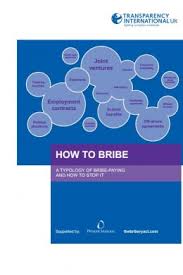Sectors - Written by Barry & Richard on Sunday, August 17, 2014 3:04 - 0 Comments
REVIEW: Transparency International: Publication – How to Bribe, a typology of bribe paying and how to stop it
 Earlier this year we and Pinsent Masons LLP sponsored the publication by Transparency International UK of this publication. It’s free, though TI request a donation of £25 – it’s a charity after all – but you don’t have to donate if you don’t want to.
Earlier this year we and Pinsent Masons LLP sponsored the publication by Transparency International UK of this publication. It’s free, though TI request a donation of £25 – it’s a charity after all – but you don’t have to donate if you don’t want to.
How to bribe, a typology of bribery and how to stop it is a compendium summary of examples of bribery as they have manifested. The idea, to enable readers to identify situations where bribery might occur in their own businesses and how.
Barry wrote the forward and was approached by TI-UK some time ago. The idea appealed as we are keen proponents of helping companies comply and making compliance relevant for business. It’s no good parroting sections of the Bribery Act or FCPA and expecting people to really understand. We think people need real life examples and practical tips and guidance. This is what the booklet offers. In Barry’s forward he said:
“This handbook should be a must-read for businesses serious about their anti-bribery programme. It is often said that you learn from your mistakes. But there really is no need. Plenty of other people have made them for you. Read this handbook and you can learn from them, there really are no excuses.
This handbook is perfect for General Counsel, Chief Compliance Officers and anyone in any company responsible for anti-bribery compliance from the Board of Directors, down.
The purpose is to show how people pay bribes in practice. The examples are based on realistic experiences or real cases.
Many bribery cases receive little attention. Often the focus is on the international examples in far away places where, it is sometimes said, you have to ‘pay the man’ to get business done. The impression given is that it would never happen at home. Yet it does. While the first two sections focus on the how, why and when bribes are sometimes paid in a short final section the handbook covers some examples of more prosaic bribery, at home. Who said it could never happen here?
Transparency International deserve credit, once again, for putting together a document designed to be practical and helpful for those keen to avoid falling into the trap of bribery.”
All true.
The publication is broken down into three sections, what is a bribe, how they are paid and bribery at home. Sections 1 and 2 contain useful guidance on what to do to spot problems highlighting red flags and also steps to take to prevent bribery.
Companies should use the examples in their training sessions. TI-UK are to be applauded again in their putting together something that helps business comply, for free.
What’s not to like?
Declaration of interest: We’re biased. Our review 5/5!


